This was published 4 years ago
Belgium: Cycling the classic cobbled roads of Flanders
By Michael O'Reilly
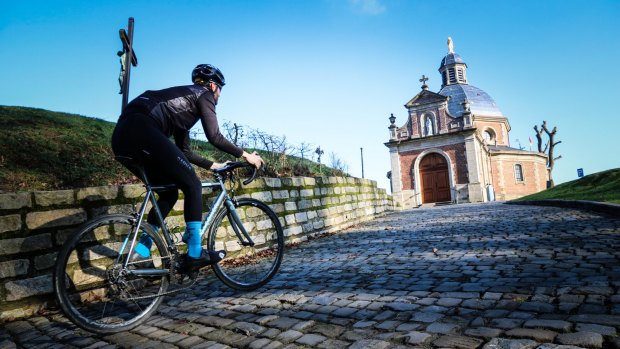
A cyclist on the final climb up the Muur van Geraardsbergen.
"This is how it must feel to be the thickest string on a bass guitar," I tell myself.
As I grip my bicycle's handlebars, waves of vibrations are travelling up my arms, to the accompaniment of a lively clatter from the bike itself.
I'm travelling along a section of the famous Flanders cobbles – short sections of historic roadway where the surface is comprised of rounded lumps of granite.
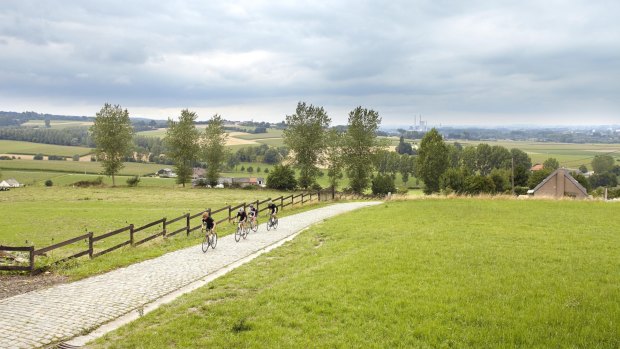
Bicycle riders take on a climb near Oudenaarde.Credit: Steven Ledoux
I've thrilled for years to the sight of professional riders tearing along these roads in the classic one-day races that range across Belgium and France. Of course, I've watched them from a comfy couch - now it's my turn to literally soak up the vibes.
Day one of my two-wheeled frolic through Flanders begins in Oudenaarde, 65 kilometres to the west of Brussels. Oudenaarde boasts a glorious 16th-century town hall, an imposing Gothic Church of Our Lady and a 12th-century abbey. More relevant to the immediate interests of our small group of enthusiasts, however, are the roads to the south.
Within 7 kilometres we are winching our way up the Koppenberg, a mainstay of the annual Tour of Flanders – 600 metres long, cobblestones all the way and with a gradient exceeding 20 per cent in places.
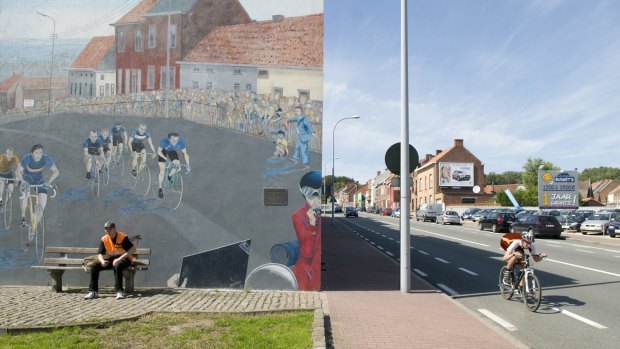
A roadside mural depicts a moment in the 1988 World Championships. Credit: Koen De Langhe
With tree-lined earth banks on each side, it feels more like a tunnel than a road, and I sit back on the saddle for added traction, while letting the bike find its way over the bumps.
I'm relieved to get to the top without having to dismount, and our group gathers on the summit to admire the farmland vistas. One hill down, goodness knows how many to go.
Led by our guide, Dries, a lean and laid-back Flandrian, we continue on a loop of the undulating landscape, seeking out sections of cobbles on rural roads with sparse traffic.
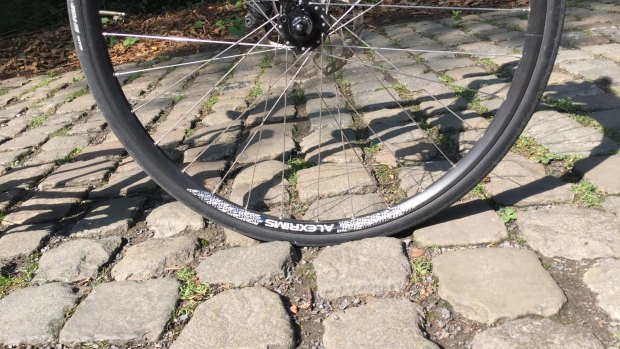
The cobbled slope of the Kemmelberg.Credit: Michael O'Reilly
During a brief halt, Dries disappears into a shop, promising to bring us some "rice cakes" - which hardly sounds appetising to a thirsty rider. Happily, he emerges with a moist, carbohydrate-stuffed tart which we scarf down with relish - so much better than an energy bar.
During our 50 kilometre circuit, we also sample the steepness of the Paterberg and the Oude Kwaremont, another two in a long list of storied cycling sites.
The quiet countryside is in stark contrast to the festival atmosphere as fans swarm the area during professional events.
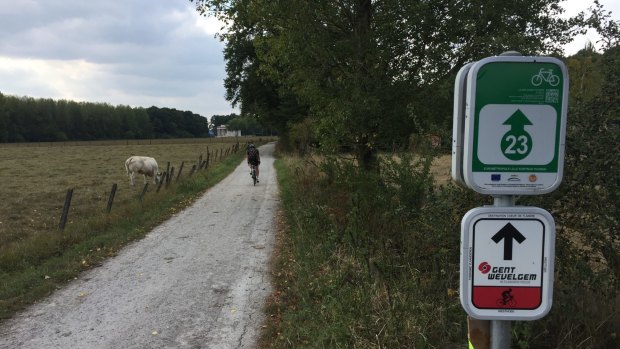
Route markers on the Gent-Wevelgem circuit. Credit: Michael O'Reilly
But there are reminders everywhere of the passion for cycling in Belgium, where riders such as Tom Boonen and Eddy Merckx are hailed as national heroes.
A mural covering the side of a building in Ronse depicts a defining moment on that road in the 1988 World Championships.
Further on, we stop to take selfies at a display celebrating the century-old Tour of Flanders, with images of every winner set into a cobbled roadside.
Across the road, a pub sells Kwaremont beer, brewed at 6.6 per cent alcohol content – the average gradient of the famous climb we've just surmounted.
Back in Oudenaarde, the Tour of Flanders Centre gives a vivid account of the region's cycling history, with photographic displays, video footage and antique exhibits.
A virtual reality headset gives an immersive experience of the life of Paul Deman, the event's first winner in 1913, who used his bike to smuggle documents during World War I. Nearby, a bike that rolls on an uneven treadmill gives one a sense of how it feels to ride over cobblestones at speed.
After our day of acclimatisation, we are ready for a bigger outing – taking part in the Vlaanderens Mooiste sportive, a mass-participation ride with distances ranging from 23 to 169 kilometres.
It's just one event on a year-long calendar of cyclosportives across the region – and, I am happy to learn, a relatively laid-back affair.
The start in Geraardsbergen is a colourful melee of cyclists adding numbers to their bikes to the disco beat of piped music.
Soon I am following a long, ragged line of riders weaving their way through tiny towns and open farmland on minor roads and rougher-surfaced bike paths, guided by direction arrows.
The useful thing about riding on flatlands – you can see the weather coming at you. The course steers us towards a threatening bank of black clouds, and we seek shelter in a tiny hamlet. But the shower is brief and we're soon chasing rainbows.
With 10km to go, the big challenge of the day arises – a tussle with the fabled Muur van Geraardsbergen. Muur means "wall" - the kilometre-long ascent runs on cobbled (of course!) roads through the town centre, and I grind along past people strolling, shopping or sipping at outdoor tables.
The finish is an Instagrammable delight – the course curves up to a pointy knoll, topped by a picturesque church. I dismount to take photos and watch my fellow participants navigate the complexities of climbing while turning on a bouncing bicycle.
It's an easy roll back to Geraardsbergen, where refreshment stalls provide me with the beer I've been craving since the Muur, chased with that cornerstone of Belgian cuisine - twice-fried chips, dipped in mayonnaise.
For many Australians, Flanders is synonymous with World War I. Our group shifts lodgings from Oudenaarde to Ypres, a city devastated in the conflict and subsequently rebuilt.
Yes, it's a cycling tour, but seriously, what better way to tour the battlefields? We spend several hours traversing the now-verdant landscape, taking advantage of 360-degree views, and finding it easy to stop at every point of interest.
Our tour guide carries a binder of historical photographs to illustrate the past, and I'm astonished to find that, in places, the markers that indicate the front lines of the combatants are just a few pedal strokes apart.
Indeed, I find riding between the sites to be a welcome head-clearer for some sombre moments of contemplation. I'm not a religious man, but it pricks my eyes to read the legend on the gravestones marking the shattered remains of an unknown soldier: "Known unto God."
We're not the only ones taking the two-wheeled route – at one stage, our party entwines with a group of riders on power-assisted bikes.
The rising popularity of e-bikes is everywhere in evidence, and one tour guide tells me that it means hesitant riders aren't worried about keeping up.
"You can have a much larger audience, making the tours more accessible – and they still get the experience," he says.
No visit to Ypres is complete without a visit to In Flanders Fields Museum and a trip to the Menin Gate, where a Last Post ceremony is held every evening to honour the missing British and Commonwealth soldiers.
After an evening of good food and double-strength beer, we head out for a 100km exploration of the Gent-Wevelgem cyclosportif, which covers similar ground to the professional race.
The course is permanently marked with signs and can be downloaded to GPS devices; regular stops on hilltops give us views of hamlets and glinting church spires in all directions, as the route treats us to the delights of rural Belgium.
It's a ride, not a race, so we take the time to stop at several points of interest, including the imposing lion statues at the Ploegsteert Memorial to the Missing and a site honouring the "Christmas truce" of 1914, when soldiers played football in no-man's land.
Lunch is in a restaurant and bike rental shop set in a picturesque brick-built house. After enjoying sandwiches while basking in the sun, it takes coffee to get back onto the bike.
Our final cobbled challenge is an ascent of the rattly, ramp-like Kemmelberg – and then, being cyclists, we turn around to tackle the famous hill from the opposite direction.
Then it's a fast sprint back to Ypres, for an early dinner and a reflection on how the Flemish roads have given me a new appreciation for the rough – as well as the smooth - of cycling.
THE DETAILS
RIDE
For detailed information on cycling in the area, see cyclinginflanders.cc
FLY
Emirates, Qatar and Cathay Pacific all fly from Australia to Brussels with one stop.
STAY
Leopold Hotel, Oudenaarde (leopoldhoteloudenaarde.com), is on the river, 200 metres from the Tour of Flanders Centre and offers cycling packages, with rooms from about €100 ($A160). In Ypres, Albion Hotel (albionhotel.be) is in a historic building a short stroll from Menin Gate with rooms from about €85 a night.
MORE
Michael O'Reilly was a guest of Visit Flanders.
Sign up for the Traveller Deals newsletter
Get exclusive travel deals delivered straight to your inbox. Sign up now.